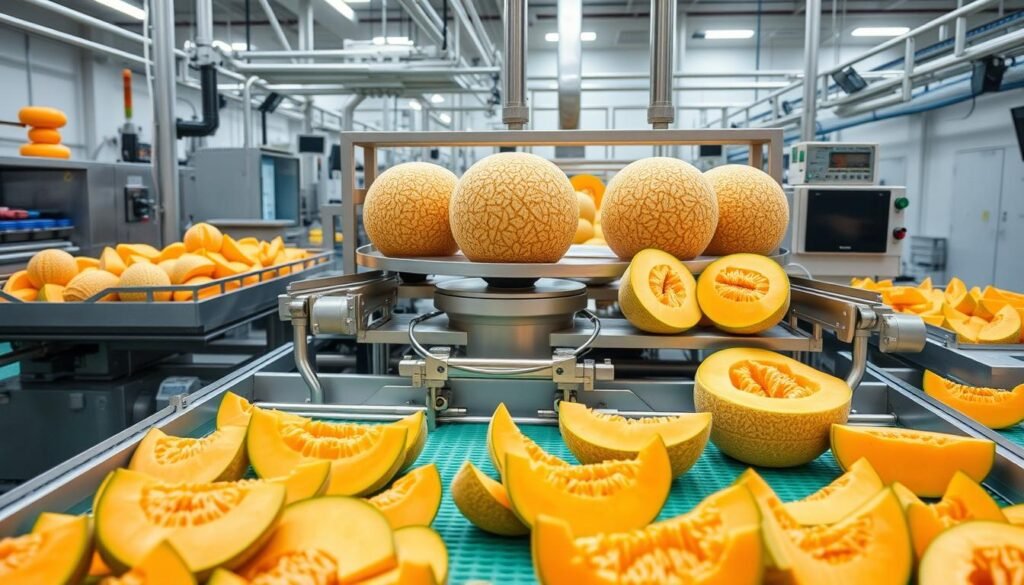G’day, mates! Let’s talk about cantaloupe and honeydew melons. They’re loved in Aussie cuisine. How do we keep their freshness and flavour up with efficient processing?
Cantaloupes and honeydew melons come from the cucurbit family. They have a long history and many varieties. Efficient processing is key to keeping melon products safe and of high quality.
Exploring cantaloupe and honeydew melon processing, we learn about their unique traits. We see how processing keeps their freshness and flavour. This is vital for the fruit industry.
Key Takeaways
- Cantaloupes and honeydew melons belong to the cucurbit family, with the scientific name Cucumis melo, and are a crucial part of fruit processing.
- Efficient processing technologies, such as cantaloupe processing and honeydew melon processing, are essential for preserving the freshness and flavour of these melons.
- The melon processing industry has seen industrialization in CIS countries and abroad, highlighting a shift towards more efficient processing technologies, including cantaloupe processing and honeydew melon processing.
- Melons are cultivated and consumed globally, with West Africa exploring the use of melon as a source of oil for biodiesel production, emphasizing the economic importance of this crop and the need for efficient fruit processing.
- The implementation of the Hazard Analysis and Critical Control Points (HACCP) system is recommended for ensuring the quality and safety of melon products, including those from cantaloupe processing and honeydew melon processing, which are key aspects of fruit processing.
- The efficiency of melon processing machines can reach up to 93% for seed shelling, 89.3% for kernel/shell separation, and 91.5% for oil extraction, showcasing the effectiveness of integrated processing equipment in fruit processing.
The Rich Heritage of Melon Cultivation in Australia
Melon cultivation in Australia has a rich history. It started with Aboriginal communities and has evolved with new farming methods. Melons have always been important in our farming.
Aboriginal Uses of Native Melons
Aboriginal Australians used native melons as a key food source. They used different types for their health benefits. Melons were part of their meals and medicines.
Evolution of Commercial Melon Farming
With European settlers, melon farming changed a lot. New melon types were brought in, improving quality and yield. Now, Australia’s melon industry is booming, thanks to better farming and technology.
Traditional Processing Methods
Old ways of processing melons included sun drying and sorting by hand. These steps helped keep the melons fresh for market. They also helped start the modern ways of handling melons after they’re picked.
| Melon Category | Characteristics | Processing Methods |
|---|---|---|
| Western (Shipping) | Sturdy, longer shelf-life | Controlled atmosphere storage, automated sorting |
| Eastern | Smaller, sweeter | Manual handling, refrigerated storage |
| Jumbo | Large size, high water content | Specialized packaging, quick cooling |
New technology has changed how we farm melons. Better ways of picking and handling melons keep them fresh. This means we enjoy cantaloupes and honeydews that are full of flavor.
Understanding Modern Cantaloupe and Honeydew Melon Processing
In today’s melon industry, we use the latest storage techniques to keep cantaloupes and honeydews fresh. We use controlled atmosphere storage to keep them fresh for longer. This way, we make sure they taste great and feel right.
We focus a lot on quality control in our processing. We check each melon carefully to make sure they meet our high standards. We look at their size, ripeness, and overall quality to pick the best ones.
Keeping to strict food safety standards is very important to us. We use top-notch sanitization systems and watch every step of processing. This way, we make sure only the safest, freshest melons get to the people who eat them.
- Advanced refrigeration systems to maintain optimal temperatures.
- Automated sorting machinery for consistent quality.
- Regular audits to comply with national and international safety regulations.
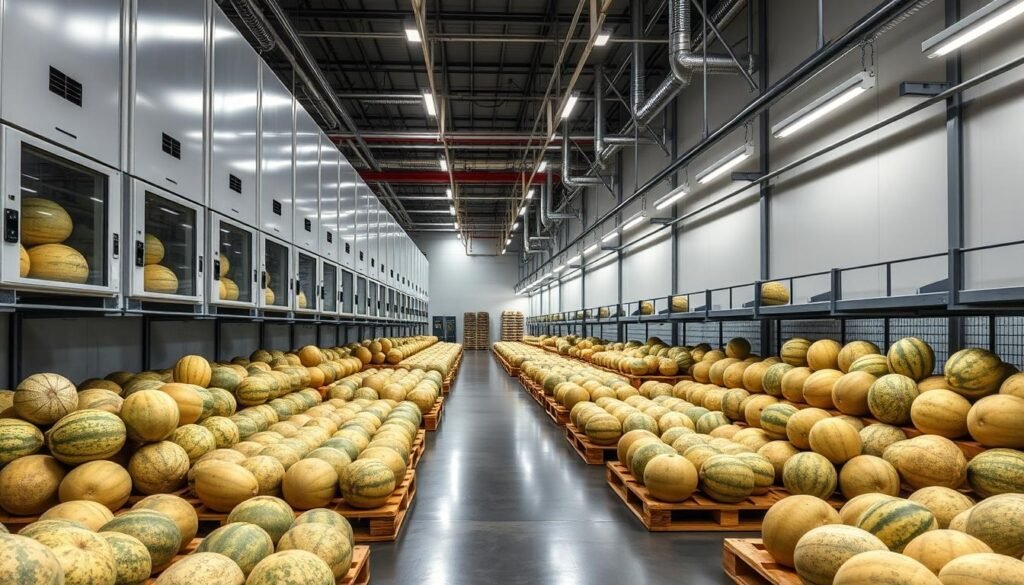
| Storage Technique | Benefits | Implementation |
|---|---|---|
| Controlled Atmosphere Storage | Extends shelf life, preserves flavor and texture | Regulates oxygen and carbon dioxide levels |
| Automated Sorting | Ensures consistent quality, reduces human error | Uses sensors and machinery to grade melons |
| Advanced Refrigeration | Maintains optimal storage temperatures, prevents spoilage | Employs energy-efficient cooling systems |
Essential Harvesting Techniques for Premium Quality
Getting the best cantaloupe and honeydew melons starts with good harvest management. We focus on picking them at the perfect time. This ensures they taste great and last longer.
Optimal Harvest Timing
We pick melons in the morning when it’s coolest. This helps keep them fresh. We look for a three quarter to full slip to know they’re ready.
Field Handling Practices
We handle each melon by hand to avoid damage. Using clean tools and sharp clippers keeps them perfect from start to finish.
Initial Sorting and Grading
We sort melons in the field first. This way, we can remove any that aren’t ripe or are damaged. It’s important for produce market research and meeting customer needs.
Keeping the soil pH between 6.0 and 6.5 is key. It helps the plants get the nutrients they need. This leads to better plant growth and more melons.
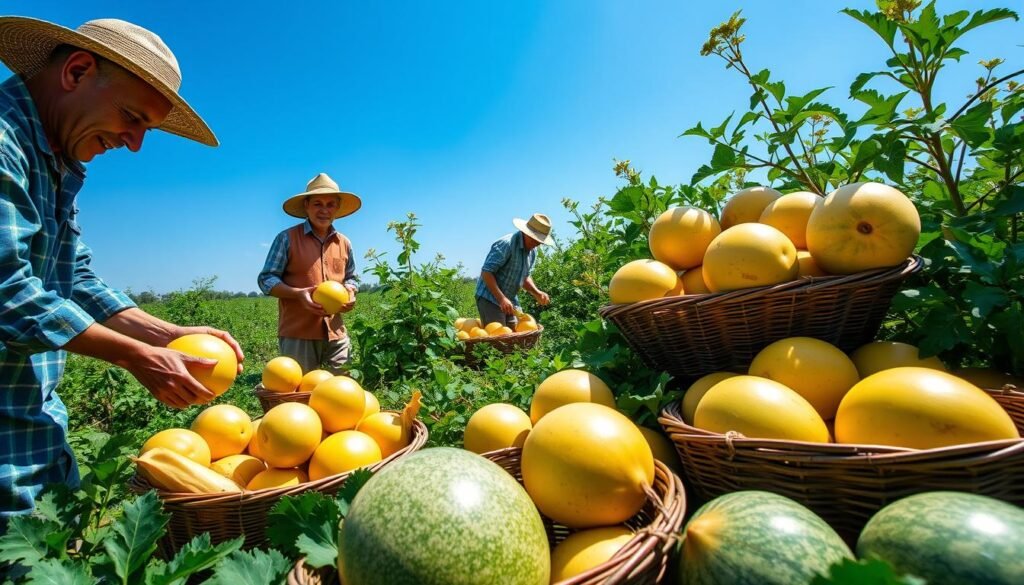
Post-Harvest Handling and Storage Solutions
Keeping our melons fresh after harvesting is key. We use advanced storage techniques to keep them in great shape. Controlled atmosphere storage helps manage temperature and humidity, keeping melons juicy and tasty.
Rapid cooling is also crucial. It slows down ripening by quickly cooling them down. This way, our cantaloupes and honeydews arrive at stores in perfect condition.
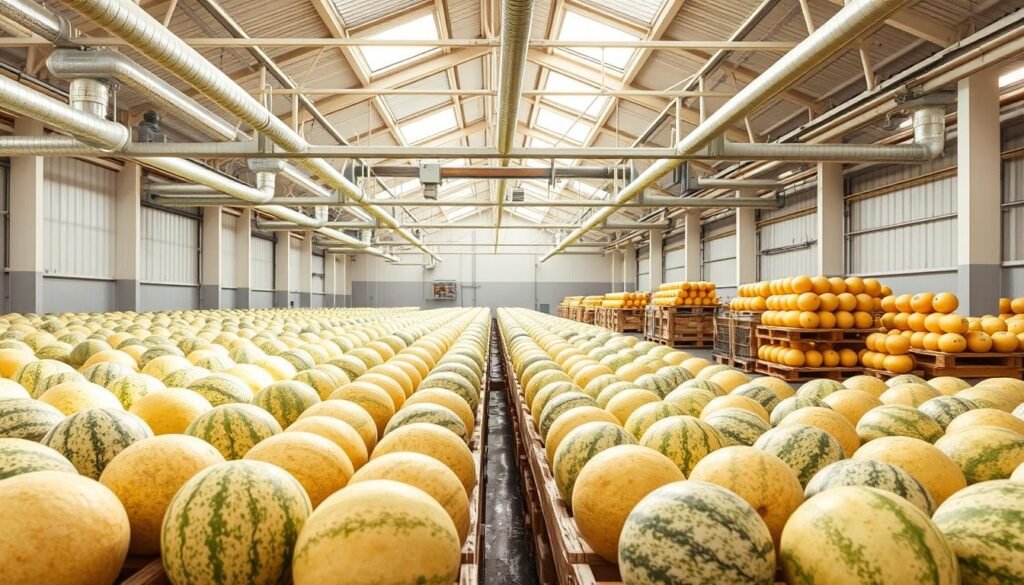
We’re leaders in agricultural technology. Our Li An machinery Fruit/Gourd Peeling machine is a game-changer. It peels and prepares melons efficiently, cutting down waste and speeding up production.
- Controlled atmosphere storage maintains optimal conditions
- Rapid cooling extends shelf life
- Li An peeling machine enhances processing efficiency
Our use of these storage techniques and agricultural technology ensures our melons stay fresh. They go from the field to your table in top quality.
Advanced Cantaloupe Processing Technologies in Modern Facilities
We use the latest agricultural technology to make sure our melons are top quality. Our modern facilities have the newest tools to keep melon quality high from farm to table.
Cleaning and Sanitisation Systems
Our advanced cleaning systems get rid of dirt, making each melon clean and safe. We use top-notch sanitisation to kill off bad bacteria. This follows strict food safety standards.
Cutting and Peeling Equipment
We have the latest cutting and peeling machines, like the Li An Fruit/Gourd Peeling machine. It makes our work more precise and cuts down on waste. This agricultural technology makes sure every slice is of the same high quality.
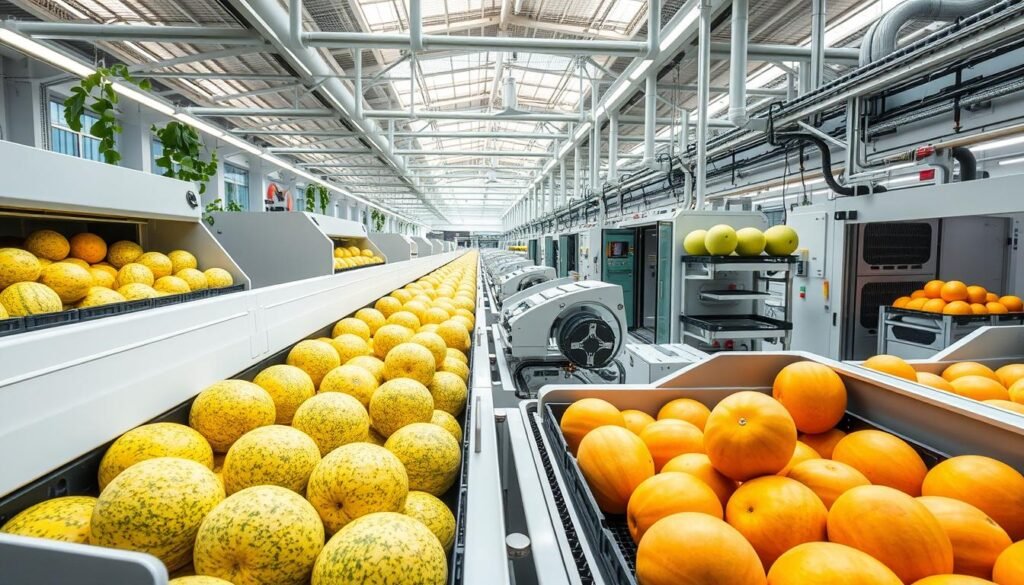
Packaging Innovations
We’ve come up with new ways to package our melons. These solutions keep melons fresh for longer and are good for the environment. Our smart packaging keeps the melons tasting great for our customers.
| Technology | Benefits | Compliance |
|---|---|---|
| Advanced Cleaning Systems | Enhanced purity, reduced contaminants | Meets strict food safety standards |
| Li An Peeling Machine | Precision cutting, minimal waste | Improves processing efficiency |
| Smart Packaging | Extended shelf life, eco-friendly | Adheres to sustainability standards |
Quality Control Measures in Melon Processing
Ensuring top quality control in melon processing is key. We follow strict food safety standards at every step. This ensures our products are safe and tasty for consumers.
Safety Standards and Compliance
Our facilities meet all food safety standards at a national and international level. We undergo regular audits and inspections. This keeps our cantaloupes and honeydews up to safety standards.
Quality Assurance Protocols
Quality assurance is central to our work. We inspect each melon thoroughly, from harvest to packaging. Our team checks for maturity, firmness, and uniformity. This way, only the best melons make it to the market.
Contamination Prevention
Stopping contamination is vital. A study in Kazakhstan showed the need for critical control points to reduce microbial risks. We’ve applied these findings, using advanced sanitization and strict handling to keep our products safe.
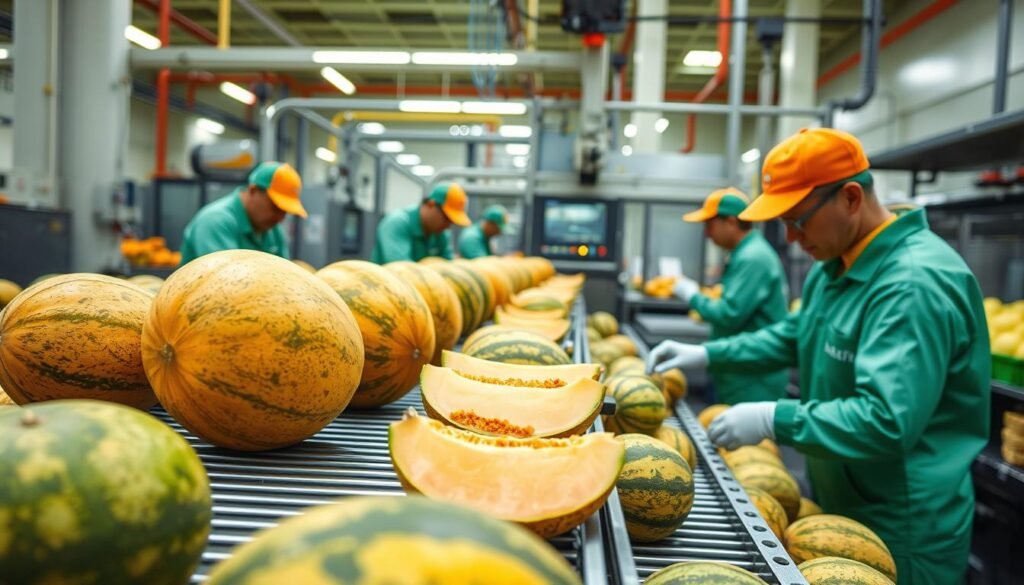
| Quality Control Aspect | Details |
|---|---|
| Number of Samples | 50 samples per batch for inspection |
| Size of Sample | Each sample consists of 10 melons |
| Tolerances | Firmness ±5%, Uniformity ±3% |
| Defects | Bruises, cracks, insect injury |
| Uniformity of Appearance | ≥ 90% uniform in size and color |
| Decay | None allowed in processed melons |
| Mechanical Injury | No visible cuts or damage |
| Maturity | Ripeness level verified before processing |
| Broken Skin | No defects allowed under quality standards |
Value-Added Melon Products and Market Opportunities
We’re excited about the wide range of cantaloupe and honeydew products in Australia. From pre-cut fruit salads to frozen melon balls, and even gourmet melon preserves, the options are endless. Fruit processing is getting more creative.
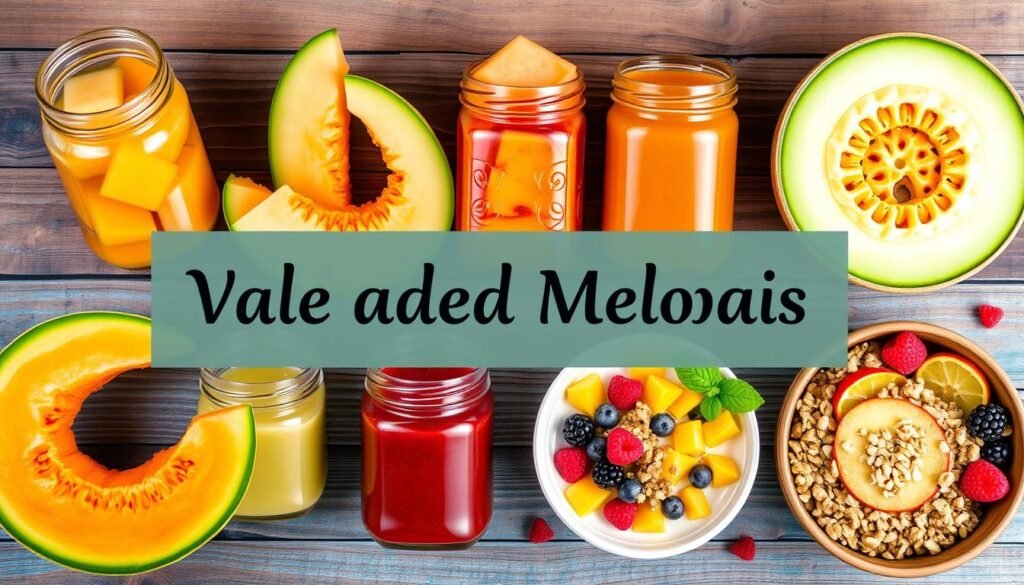
Our produce market research reveals a rise in demand for easy and healthy snacks. Fresh-cut fruits, like melon mixes, are a big hit, making up 31% of the market. They’re expected to hit up to $2 billion in sales soon.
- Pre-cut fruit salads
- Frozen melon balls
- Gourmet melon preserves
- Fruit-infused beverages
People want snacks that are both nutritious and simple to use. Our fruit processing keeps these products fresh and tasty. This meets the needs of health-focused buyers. Melons are also packed with vitamins and minerals, making them a great choice.
By keeping up with produce market research, we can spot trends and create new products. This not only boosts our offerings but also opens up new markets. It drives growth in the melon processing industry.
Sustainable Processing Practices for the Future
We’re dedicated to making melon processing better for the planet. We use agricultural technology to be more efficient and cut down on waste.
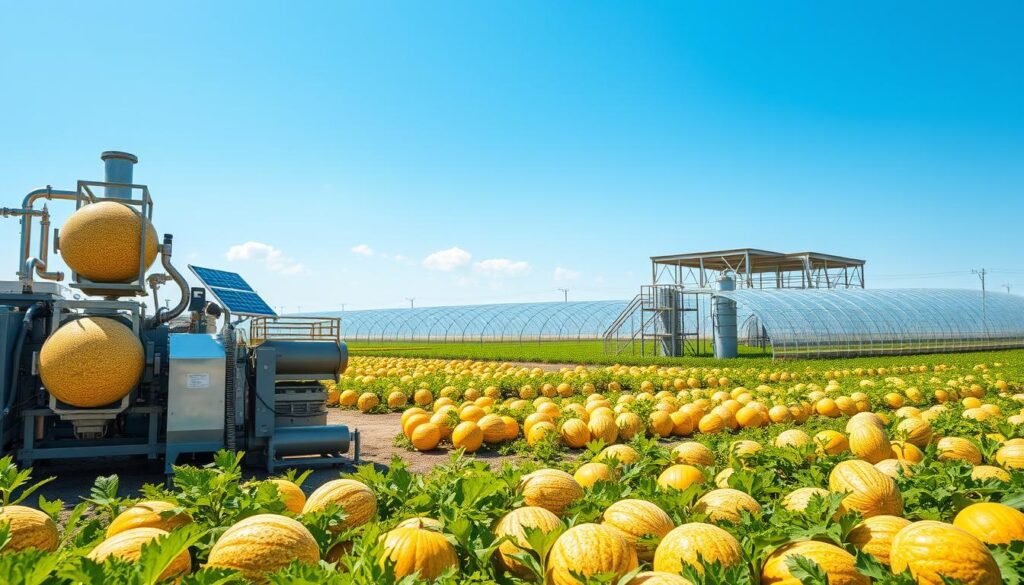
Energy-Efficient Technologies
Our places use solar cooling and heat recovery units. These steps help us use less energy and reduce carbon emissions.
Waste Reduction Strategies
We aim to use every part of the melon. Here’s how:
- Turning rinds into animal feed
- Extracting seeds for oil
- Creating packaging from melon fibers
Environmental Considerations
Water saving is key. We collect rainwater and use recycled water. Our produce market research also helps us meet eco-friendly consumer needs.
With these steps, we make sure melon processing stays tasty and green for years to come.
Conclusion: Embracing Innovation in Melon Processing
Innovation is key to our success in the melon processing industry. By using the latest technology, we keep our cantaloupes and honeydew melons fresh and tasty. This ensures they are enjoyed from the farm to your table.
The Li An machinery Fruit/Gourd Peeling machine has changed how we work. It makes our processing lines more efficient and reliable. This helps us keep our quality and safety standards high, which is important in today’s market.
We also focus on food safety. For example, hot water immersion treatments help reduce harmful bacteria in cantaloupes. This makes our melons safe for everyone to enjoy and boosts our reputation for quality.
Looking to the future, we will keep improving our melon processing. We will use sustainable practices and new technologies. This will make sure Australian cantaloupes and honeydew melons stay a favorite choice for their taste and quality.
By embracing these advancements, we’re excited for a future where our melons are even better. Our processes will be smarter, and our industry will be stronger than ever.
FAQ
What are the origins of cantaloupe and honeydew melons in Australia?
Cantaloupe and honeydew melons have a long history in Australia. Aboriginal communities used native melons before farming started. European settlers then brought new varieties, creating the diverse melon industry we have today.
How do advanced processing technologies preserve melon freshness and flavour?
We use advanced storage methods like controlled atmosphere storage and rapid cooling. These keep the melons fresh for longer. We also use new packaging to keep them fresh from farm to table.
What are the best practices for harvesting cantaloupes and honeydews?
Picking melons at the right time is key for taste and shelf life. We handle them gently in the field. We also sort and grade them to ensure only the best reach the market.
How does quality control ensure the safety and quality of melons?
We follow strict food safety rules and quality checks. These steps help prevent contamination. This means every melon Aussie consumers get is safe, fresh, and tasty.
What value-added melon products are available in the Australian market?
The industry offers many products like pre-cut fruit salads and frozen melon balls. These are great for healthy, easy snacks.
How is sustainability integrated into melon processing practices?
We use energy-saving tech like solar cooling systems. We also reduce waste and use eco-friendly packaging. This helps us be kinder to the environment.
What role does agricultural technology play in modern melon processing?
Tech is crucial for better harvest and processing. It helps us work more efficiently. For example, the Li An machinery Fruit/Gourd Peeling machine makes our work easier.
How does market research influence melon processing and product development?
Market research helps us understand what people want. It guides us in creating new products and improving our methods. This way, we meet the market’s needs better.
What are the traditional processing methods for melons, and how have they evolved?
Old methods were manual and simple. Now, tech has changed everything. We can harvest, store, and check quality more efficiently, meeting today’s standards.
How do food safety standards impact melon processing in Australia?
Following strict food safety rules is essential. We keep up with laws to ensure our melons are safe. This keeps our products clean and of high quality.
Source Links
- Cantaloupe and Specialty Melons – https://extension.uga.edu/publications/detail.html?number=B1179&title=cantaloupe-and-specialty-melons
- Means of Mechanization and Technologies for Melons Processing – https://www.academia.edu/107615596/Means_of_Mechanization_and_Technologies_for_Melons_Processing
- An Innovative Layer-by-Layer Edible Coating to Regulate Oxidative Stress and Ascorbate–Glutathione Cycle in Fresh-Cut Melon – https://www.mdpi.com/2311-7524/10/5/465
- How to grow Rock Melon and Cantaloupe – https://www.diggers.com.au/blogs/learn/how-to-grow-rock-melon-and-cantaloupe?srsltid=AfmBOor9evfj33CV5KDxPtDOe7v1nrAnHDsw8KIYNqh6wyR1k9yWxiU_
- Plant Science Today – https://horizonepublishing.com/journals/index.php/PST/article/download/1300/907/9175
- Melons: Cantaloupe, Muskmelon, Honeydew, Crenshaw, Casaba, etc. – https://horticulture.oregonstate.edu/oregon-vegetables/melons-cantaloupe-muskmelon-honeydew-crenshaw-casaba-etc-0
- Life_4.indd – http://www.journal.eu-jr.eu/life/article/download/2636/2039
- High-Intensity Ultrasound Processing Enhances the Bioactive Compounds, Antioxidant Capacity and Microbiological Quality of Melon (Cucumis melo) Juice – https://www.mdpi.com/2304-8158/11/17/2648
- Harvest practices for melon – https://www.freshknowledge.eu/en/increase-your-knowledge/crops/melon/harvest-practices-for-melon.htm
- A quick guide to harvesting and storing melons, squash, and pumpkins – https://blog-fruit-vegetable-ipm.extension.umn.edu/2021/09/a-quick-guide-to-harvesting-and-storing.html
- Melon Production – Oklahoma State University – https://extension.okstate.edu/fact-sheets/melon-production.html
- Postharvest Handling Systems: fruit vegetables – https://vric.ucdavis.edu/postharvest/fruitveg.htm
- The melon: storage, tranportation and conservation. – https://antoniomarco.com/news/en/the-melon-storage-transportation-and-conservation/
- Melon Fruit: Quality, Production & Physiology – Felix Instruments – https://felixinstruments.com/blog/melon-quality-production-physiology/
- PDF – https://journal.eu-jr.eu/sciencerise/article/download/2870/2183
- Eco-energy and environmental evaluation of cantaloupe production by life cycle assessment method – https://pmc.ncbi.nlm.nih.gov/articles/PMC9362568/
- Microsoft Word – Cantaloups_4-2006 .docx – https://www.ams.usda.gov/sites/default/files/media/Honeydew_Inspection_Instructions[1].pdf
- melonfoodsafety.qxp – https://www.fda.gov/media/116691/download
- Melons – https://www.agmrc.org/commodities-products/fruits/melons
- EC-732 2.05.indd – https://www.extension.purdue.edu/extmedia/ec/ec-732.pdf
- MelonPMSP2003FinalCA.doc – https://ipmdata.ipmcenters.org/documents/pmsps/CAMelon.pdf
- Michigan Fresh: Using, Storing, and Preserving Melons – https://www.canr.msu.edu/resources/michigan_fresh_melons
- Nano- and Micro-Encapsulation of Long-Chain-Fatty-Acid-Rich Melon Seed Oil and Its Release Attributes under In Vitro Digestion Model – https://www.ncbi.nlm.nih.gov/pmc/articles/PMC10296856/
- Microsoft Word – master.doc – https://ufdcimages.uflib.ufl.edu/uf/e0/01/14/67/00001/nunezpalenius_h.pdf

